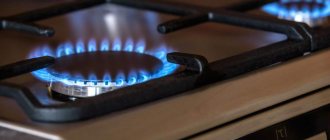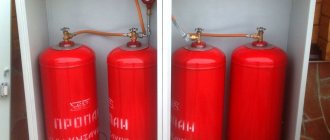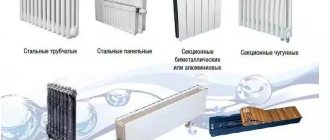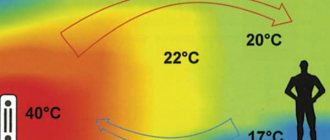Home / Gas boilers
Back
Published: 06/03/2019
Reading time: 3 min
3
2446
Owners of private houses are often interested in how much gas a gas boiler consumes per month. You can find out the numbers through correct calculations. Methods for measuring gas consumption and methods for reducing this level are discussed further in the article.
- 1 Approximate gas consumption 1.1 What affects gas consumption
- 1.2 How to reduce gas consumption
- 2.1 Approximate calculation of energy consumption
Gas consumption by a heating boiler, calculation when purchasing equipment
When planning the purchase of a gas heating boiler, you should carefully study the efficiency of the purchased equipment for a particular house or apartment, especially in terms of gas consumption.
Boilers are produced in two main types:
- Wall-mounted ones are suitable for hot water supply and heating of apartments and residential buildings with an area of up to 200 sq.m. They are small in size, can be placed on the wall and do not take up much space in the kitchen, where they are most often installed. Wall-mounted boilers are single-circuit (for heating only) and double-circuit (for heating and water heating). The principle of heating water is flow-through.
- Floor-standing boilers are more powerful than wall-mounted ones and are designed for heating large areas (shops, production workshops, hospitals, schools, etc.). They are divided into devices with forced-air and atmospheric burners. They are located in a special room, which must meet a number of technical parameters.
In this article we are more interested in wall-mounted units
When choosing a boiler, you should pay attention to its efficiency level. For standard blue fuel boilers, the efficiency is 92-93%, for condensing boilers - 108-109%
The hydrocarbon consumption criteria are:
- type and power of equipment, burner operating mode,
- room area,
- level of insulation of external walls,
- the presence and number of doorways and windows,
- gas quality (caloric content level).
Heating wall devices are divided into devices:
- With an open combustion chamber, which uses natural draft chimneys to exhaust exhaust gases. They are more often used in private homes or on the upper floors of high-rise buildings, where there is good traction.
- With a closed combustion chamber with a coaxial chimney. They are equipped with a special smoke removal system and do not use air from the room to support the combustion process. Mainly used for apartment-by-apartment individual heating.
Floor models
FERROLI PEGASUS D 30
The FERROLI PEGASUS D 30 single-circuit floor-standing gas boiler is capable of heating rooms up to 300 m². It is equipped with a cast iron heat exchanger and an open burner. Can operate on both main and bottled fuel. It has a digital control panel with the ability to connect a programmer and temperature sensor. There is a “Summer” mode.
The operation of the control system is ensured by connecting to electricity. It is necessary to connect a voltage stabilizer to maintain warranty service for 2 years. The combustion products are removed using a classic chimney. The characteristics of FERROLI PEGASUS D 30 are as follows :
- Efficiency = 91.8%;
- maximum coolant temperature - 95°C;
- gas consumption – up to 3.41 m3/hour;
- country of origin: Italy.
Vaillant VK INT 356 30
The Vaillant VK INT 356 30 condensing floor-standing gas boiler can heat rooms up to 300 m². It has one heat exchanger and a built-in boiler to provide warm water. Equipped with a closed combustion chamber. The modulating burner can change the power level from 30% to 100%. It is distinguished by reliability, long service life, low noise level and high performance. A coaxial chimney is used to remove combustion products.
The main characteristics of this unit are as follows::
- Efficiency = 108%;
- maximum coolant temperature - 85°C;
- gas consumption – up to 3.41 m3/hour;
- country of origin: Germany.
Protherm Bear 30 TLO
Non-volatile single-circuit gas floor heating boiler Protherm Bear 30 TLO. It has a cast iron heat exchanger for heating, but if desired, the boiler can be equipped with an indirect heating boiler - this will require connecting to electricity. Works on both main and liquefied fuel. The coolant circulates naturally.
The unit is equipped with an atmospheric burner, so a classic smoke exhaust system is used to remove combustion products.
The gas boiler has the following characteristics:
- Efficiency = 90%;
- maximum coolant temperature - 85°C;
- gas consumption – up to 3 m3/hour;
- country of origin: Slovakia.
Model range and characteristics of Baxi floor-standing gas boilers
https://oteple.com/modelnyj-ryad-i-xarakteristiki-napolnyx-gazovyx-kotlov-baxi/
Which floor-standing gas boiler is the best - review of foreign and domestic models
Baxi SLIM 1.300 I
Single-circuit floor-standing gas boiler with electronic flame modulation. Equipped with a primary cast iron heat exchanger and an open type burner. This unit is capable of heating an area of up to 300 m². It has electronic flame modulation, a self-diagnosis system and is adapted to Russian conditions. The unit can be reconfigured to operate on liquefied fuel. Its compact dimensions allow you to place the boiler in any interior.
The operation of the control system is ensured by connecting to electricity. It is necessary to connect a voltage stabilizer to maintain warranty service for 2 years.
The characteristics of the gas boiler are::
- Efficiency = 90%;
- maximum coolant temperature - 85°C;
- gas consumption – up to 3.49 m3/hour;
- country of origin: Slovakia.
Lemax Premium-30
The floor-standing, non-volatile gas boiler Lemax Premium-30 with an atmospheric burner is designed for heating country houses, cottages and industrial premises with an area of up to 300 m². May have one circuit or two. Heat exchangers are made of steel. The unit is capable of operating on both natural and liquefied fuel. This non-volatile boiler will be able to heat the room even in the event of a power outage. The unit is equipped with an open combustion chamber, weather-dependent automation and has a “Summer” mode. The warranty period is 3 years. A classic chimney is used to exhaust smoke.
The gas boiler has the following characteristics:
- Efficiency = 90%;
- maximum coolant temperature - 90°C;
- gas consumption – 1.75 m3/hour;
- hot water productivity (Δt=35°C) – 5.7 l;
- country of origin: Russia.
What affects consumption?
A gas boiler is a complex device. The process of its operation and fuel consumption depend on various factors. One of the most important is the power of the boiler. The volume and area of the structure that needs to be heated is also important. At the same time, it is worth taking into account the features of the building, the material from which it is built, the quality of the insulation, etc., which affects the degree of heat loss, as this leads to an increase in heating costs.
Gas consumption during boiler operation is an important indicator. As practice shows, expensive units have this indicator lower. Therefore, it is better to install them. During operation they will pay for themselves quite quickly. This will allow you to save money on gas bills. Unlike such equipment, cheap equipment cannot boast of this. Therefore, whether it makes sense to purchase them is up to you to decide.
What determines the price of heating?
The cost of heating a home is determined by the price of fuel and the volume of its consumption. The product of these two quantities, as well as the length of the time period for which the calculation is required, gives the amount of money invested in heating alone. Gas consumption from main networks is measured in liters or m³, and from bottled gas - in kg. The cost of methane is 4 times less than that of a mixture of butane and propane.
Due to the lower calorific value, the consumption of the first type of gas consumed by the unit will be 3 times higher to produce the same amount of energy. As a result, payments for any type of gas become approximately the same.
Device Features
When choosing a device, it is necessary to take into account its cost-effectiveness and efficiency. As practice shows, the most common type of device is gas boilers, since they operate using fuel, which is available in any home. Thanks to modern progress, gas is available even in small villages. Therefore, people use it for different purposes: cooking, heating the house, heating water and more.
During its operation, a boiler of this type feeds a significant amount of fuel. This must be taken into account when installing and using it in your home. But there are many ways to help reduce them
To do this, it is important to take into account the design features, model, brand and other characteristics of the unit. Then it will be easy for you to choose the one that is the best option for your home, which will allow you to save gas costs and money on its payment.
Average calculator for calculating gas consumption for heating a house
Finding out gas consumption for the last season is quite simple. It is enough to take into account the monthly meter readings. When the heating season comes to an end, you should simply add up all the data.
Next, the arithmetic average is calculated. But to calculate the required amount of gas at the stage of purchasing a boiler, you will need to use a special formula. Gasification of an autonomous system of a private house, cottage or apartment involves the use of an average calculator, while determining heat loss. This is just an approximate calculation.
Methods for calculating specific:
- Depending on the total area of heated rooms. Here they rely on the climatic conditions of the region. For 1m2 you will need approximately 30-40 watts.
- Considering the total area of the building. So every square meter of a room with a room height of 3 m requires 100 W of heat. You will also need to take into account the climate of the region.
The main thing when making calculations is to take into account the required boiler power, which is capable of providing the premises with the required heat. When calculating, they are guided by the average figure for which 1 kW of energy is used per 10 m2. Although this calculation is the simplest, it cannot take into account all the features of the region and the building itself.
Calculating gas use will help not only choose the right boiler, but also reduce gas consumption costs. This will help save on heating costs. This way you can insulate your house and find ways to reduce heat loss.
We take out a calculator
In order to preliminarily determine the average consumption of the future system, it is necessary to calculate the planned heating area, since the power of the gas boiler is selected based on this parameter. Which in turn, as we already know, determines future consumption.
It is generally accepted that to heat 10 square meters of a room with ceilings no more than 3 meters, 1 kW of heater power is required. We further assume that 1 kW of boiler power consumes approximately 0.112 cubic meters of gas.
For example, let's take a house with an area of 100 square meters. For heating you will need a gas boiler with a capacity of at least 10 kW. It’s easy to calculate - 1.12 m3 of gas will be required per hour. If the heating system of the house is designed competently and professionally, and the house is sufficiently insulated and free of unnecessary heat loss, then in the cold winter season the gas boiler will turn on the burner for about 14 hours a day.
Based on previous calculations, we determine that the boiler will consume 14 x 1.12 = 15.68 cubic meters of natural gas per day. Therefore, per month it turns out: 15.68 x 30 approximately 470 m3.
Total
Undoubtedly, when installing an individual heating system, professional calculation of all parameters and the correct selection of an individual gas boiler in terms of power and other parameters are very important. When purchasing such a unit, count on long-term operation, and for long-term savings, choose a unit with high efficiency, albeit more expensive. This will make it possible to optimize gas consumption and, as a result, save your money.
Gas heating of a private home is convenient in all respects - both from the point of view of ease of use and from the point of view of quite acceptable energy tariffs. In any case, it has few competitors in terms of efficiency, with a well-functioning system. But not everyone can afford this for the banal reason that not all populated areas, and even more so, holiday villages, are connected to gas mains.
And yet, a solution is visible - it is possible to use imported liquefied gas for heating needs, organizing its supply to the heating boiler from cylinders or from a large underground storage facility - a gas holder
But at the same time, information on average fuel consumption is of particular importance - it is necessary not only to plan the heating budget, but also to organize the replenishment of your reserves in a timely manner
What should I do? It's okay - a calculator for liquefied gas consumption for heating will help us in this matter.
Explanations for conducting calculations will be given below in the text block.
The most energy-intensive gas equipment in a residential area is a gas boiler, which provides water heating in the heating system, and often for domestic needs. Individual gas heating is becoming increasingly attractive to consumers who do not want to depend on the problems of centralized heating.
Features of liquefied fuel
Liquefied gas is produced by converting natural fuels into a liquid state. To do this, it is cleaned of impurities, and then cooled until condensation. This technology allows you to reduce gas volume up to 600 times. Liquefied fuel is stored in cylinders that are connected to the boiler. This heating system is suitable for private homes if there is no centralized gas supply.
Consumption of liquefied fuel depends on the same factors as for conventional natural gas. On average, a 10 kW unit consumes 0.86 l3/hour of bottled fuel. A gas boiler with a capacity of 30 kW consumes approximately 2.58 l3/hour.
Wall boiler
Gas boilers can not only be installed on the floor, but also mounted on the wall. If the second option is used, then the device operates using electricity. Therefore, it is necessary to take this into account when calculating the costs of its maintenance.
Electrical energy facilitates various processes in the system. This includes pump circulation, automatic system adjustment, ignition, fan, etc. Therefore, there is no way to avoid costs of this type in a wall-mounted gas boiler.
But few people know how much electricity a gas boiler consumes. It is quite logical that this question arises. Electricity consumption at different stages of its operation differs. So, in operating condition this value is 65 W, and as soon as it ignites, the electricity consumption almost doubles and amounts to 120 W.
It is also worth considering additional elements in the unit. If there is a fan, then it also requires electricity to operate. In this case, the cost of operating the device increases by 30-35 W. By summing up these values, you can get how much electricity a gas boiler consumes.
Calculation of gas boiler consumption
Boiler installation diagram.
Correctly calculating gas consumption for autonomous heating is not difficult; it does not require special skills, you just need to know the basic parameters. To do this, we need to know the power of the unit and the area of the heated room. The heating season per year can be up to 250 days. But as a rule, during this period we do not always turn on the gas boiler at full power. After all, winters can be both very cold and relatively warm, therefore, even with maximum load on the heating system, the boiler operates at full capacity for less than 100 days. If we assume that the boiler operates all day long for 30 days and multiplying these data, we get kilowatt-hours. However, as we said earlier, the boiler is not operated in this mode, so this figure can be safely divided by 2, and thus we get the average consumption per month. We multiply it by the number of months of the heating season (usually 7) and get gas consumption for the year. As for the boiler power, it is taken from the calculation of 1 kW per 10 m².
Let's look at how this works using a separate example. If the area of your premises is 100 m², then you need to choose a boiler with a capacity of at least 10 kW. To calculate gas consumption, we multiply the boiler power by 24 hours and by 30 days, it comes out to 7200, divide in half and get the monthly thermal energy consumption, which is equal to 3600 kW/hour. To calculate for the entire heating season, we multiply this figure by 7 (the number of heating months) and get the annual boiler power consumption or annual consumption in the amount of 25,200 kW/hour.
This figure won’t mean anything to most people, so consumption can be converted into a monetary equivalent. To do this, you need to know the exact cost of gas per 1 kW/hour. For example, it is 15 kopecks. We take our calculated data of 25200 kW/hour and multiply it by 0.15. Thus, we get annual heating costs in the monetary equivalent of 3780, that is, the price for heating a room with an area of 100 m².
Gas boiler chimney diagram.
To make the picture clearer, you can calculate the gas consumption for heating in m3. To generate thermal power of 1 kW, on average, a boiler consumes 0.112 m3. We have already found out that the boiler power consumption per 100 m² should be 10 kW, multiply it by 0.112 and get gas consumption per hour of 1.12 m3. The data obtained can be multiplied by 24 to obtain gas consumption per day. The formula looks like this:
- 1.12*24=26.88 (consumption per day);
- 26.88*30=806.4 (monthly expense);
- 806.4*7=5644.8 (consumption for the heating season).
Now all that remains is to multiply the resulting figure by the tariff. It seems to you that this is not so much, but ever-growing tariffs force us to look for all sorts of ways to save money, and why pay more if it is possible to reduce the consumption of “blue” fuel. And when we are talking about a country house with an area of 800 m²? Let's try to figure out how to reduce the amount of natural gas consumption for heating.
Main gas flow rate in gas heating boilers formula
Gas consumption in boilers directly depends on the power of the heater. The necessary power calculation is carried out when purchasing heating equipment. In this case, they rely on the size of the heated area. The calculation is carried out individually for each room, taking into account the lowest average annual temperature.
When calculating power, they use the ratio of kilowatts per 10 m2 of space that is heated. Taking into account temperature changes, only half of the value will be needed, which is only 50 W per hour. For an area of 100 m2, 5 kW is enough. Formula for calculating natural gas: A = Q / q * B.
Explanation of the formula:
- A – the required amount of gas for heating;
- Q – boiler power for heating a house (5 kW is enough for 100 m2);
- q is the minimum amount of specific heat, measured in kilowatts and depends on the type of gas;
- B – boiler efficiency, percentages should be converted.
To determine consumption, simply substitute the original data into the formula. For a house with an area of 100 m2, 0.557 cubic meters per hour is enough. For 150 m2, 0.836 will be required, and for an area of 200 m2 - .114. To find out how much a gas unit consumes per day, simply multiply the resulting number by 24. Multiplying the indicator by 30 will determine how many cubic meters are needed for heating per month.
Factors affecting gas consumption
There are three factors that affect gas consumption in your home:
- Heat loss. Each house has its own amount of heat loss and in each unit of time the heat loss of the house is different. They are often calculated based on the lowest temperature values in your region. Calculating them is quite simple. The Internet is full of ready-made calculators. Losses in a house are influenced by a lot of factors: thickness and materials of walls, insulation, windows, doors, ceilings. Simply put, absolutely everything affects losses
Heat loss is measured in kilowatts, as is the boiler power. As you already understood, the boiler power is selected based on the amount of losses.
- The heating system itself. Whatever one may say, if your heating system is not thought out and balanced, then excess consumption will also be observed. Not as significant as with heat loss, but it will still happen. In this case, usually there will be overheating in some rooms, and underheating in others.
- The boiler itself. Depending on the type of boiler, gas consumption also depends. Floor-standing boilers consume more, wall-mounted boilers consume less.











